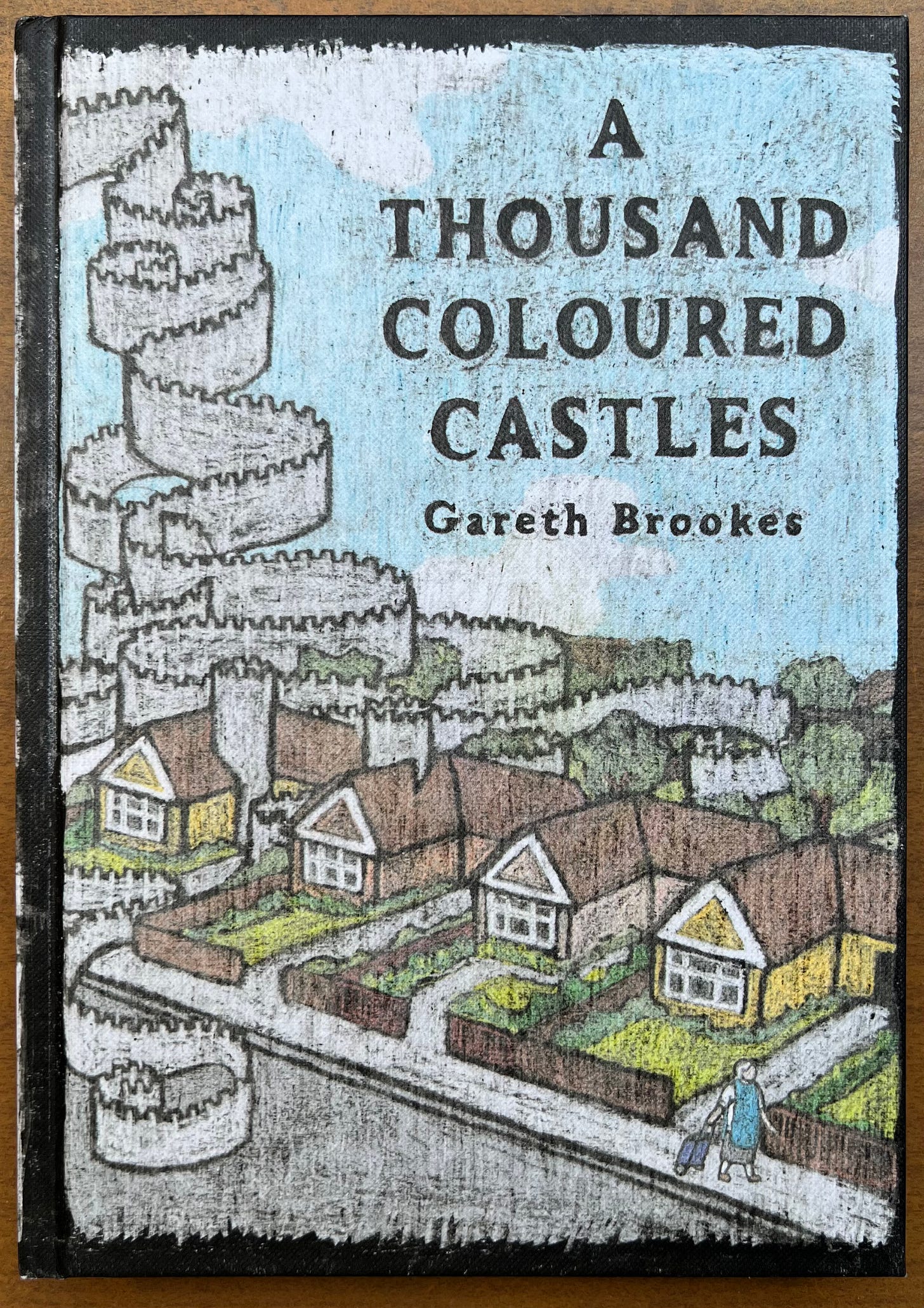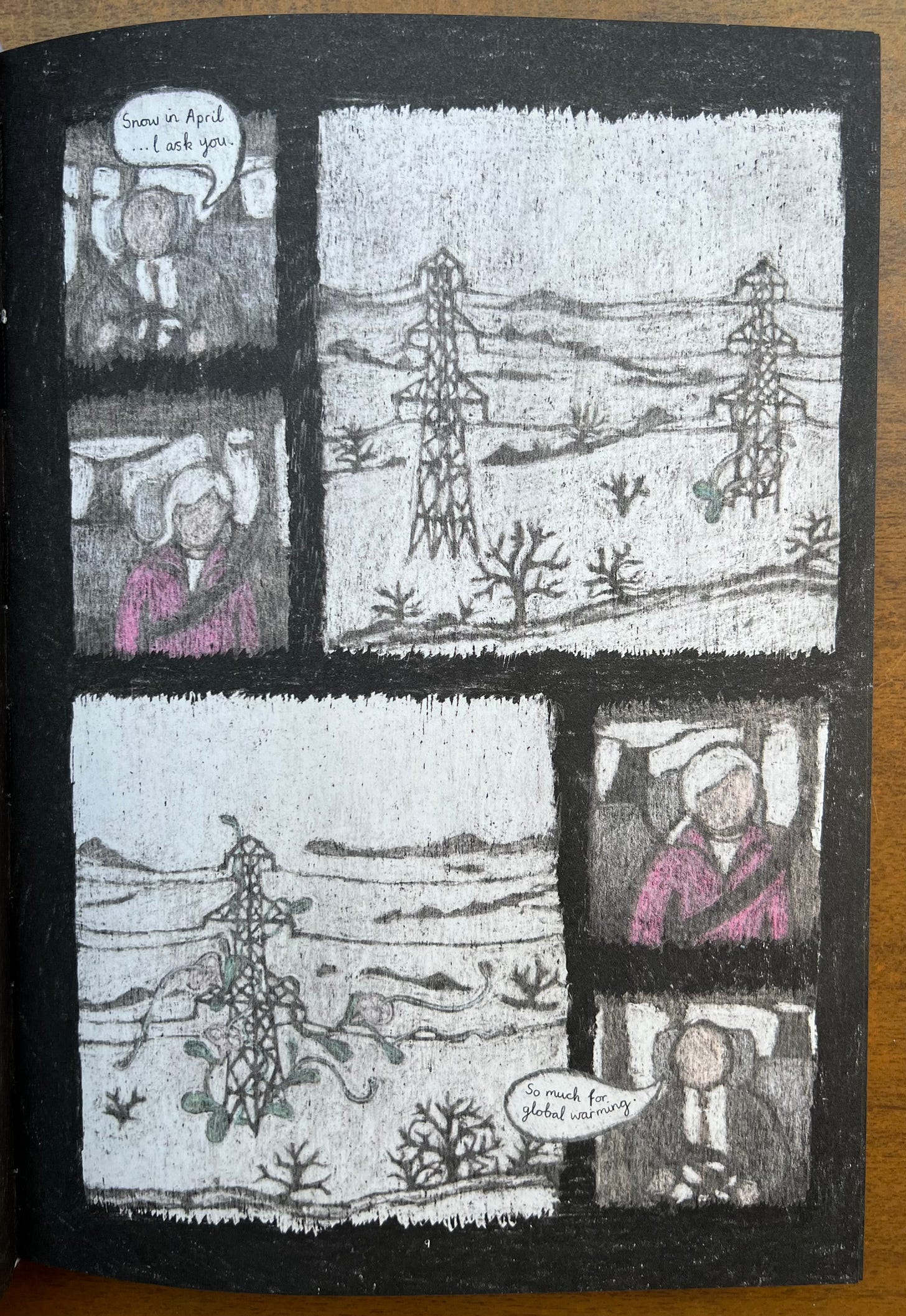The Dan Clowes of middle England? - thoughts on “A Thousand Coloured Castles” by Gareth Brookes
Why I read this
I discovered Gareth Brookes through the graphicnovels subreddit. I had not heard of him before, but the subject matter of his books seemed unique. This book in particular caught my eye.
The story is about Myriam, an old-age pensioner in England who starts to see things. And when I say things, I mean really far out psychedelic things!
Brookes is also fascinating because of the unusual media that he uses to create his books. “A Thousand Coloured Castles”, for example, was drawn entirely with wax crayon.
Before reading, I did have some concerns that this might be one of those alternative comics that eschews drama, plot twists, character development etc in favour of a quirky artistic vision, which for me is rarely enough. I’ve been disappointed by things like some of the stories in Kramers Ergot - where there was lots of inventiveness and unusual techniques on show, but not enough actual narrative.
If you haven’t read the book and sshare the same concerns, let my high rating reassure you. But I will say no more to prospective readers, because I think this book really is best read without any further information.
***SPOILERS*** from here on
How was the experience?
The wax crayon artwork is both unique and thematically appropriate. The hazy details (eg characters do not have facial features) parallel Myriam’s failing eyesight. Everything is somewhat blurry, as if in a fog. Outlines only, the small details must be filled in by memory. Form and content work together, which I love to see.
I also always love when comics use different colours and/or formats for different contexts or characters. This was beautifully done here.
The book balances mystery and poignancy with humour. Myriam’s husband Fred stands out as a person that’s comically grumpy, small-minded and entirely unimaginative. There are many revealing details about their relationship with each other, and with the outside world.
My initial skepticism of there being an actual story in the book paralleled the scepticism with which Myriam’s condition is met. I was initially dismissive of the artist, wrongly thinking that he was merely playing around with his psychedelic drawings, just as Myriam’s visions were wrongly dismissed as nothing real or serious.
I was delighted that there was an actual solid plot to the story, and indeed the final reveal was enlightening, especially if you go in with a minimum of background knowledge.
What stayed with me?
I read this in the same month that I read a number of superhero graphic novels (Catwoman: Lonely City, Batman: Haunted Knight and Wonder Woman: Historia) and it raised an unexpected question. Can an elderly lady be a more interesting protagonist than Catwoman, Batman or Wonder Woman? In the context of those other books I read that month, Myriam is more lonely than Catwoman, more haunted than Batman and certainly older and ultimately more heroic than (baby) Wonder Woman.
It’s worth noting that the main character is female, elderly and disabled, but her story never feels like a checkbox exercise to satisfy a diversity requirement. No, her story feels genuine and she is portrayed with dignity and agency.
Ultimately, Myriam’s story is poignant. How do we treat our relatives and the elderly in general when they start to cognitively deteriorate? There are no easy answers here for us, other than to try to remain decent human beings.
Fred is also a fascinating character. He made me consider that an eager imagination can indeed be harmful. A lack of imagination keeps one grounded. Keeps one interacting with the “real” world, rather than with one’s own imagination. Of course, that too is perception - the unimaginative are just as prone to be trapped in their own little worlds.
The Dan Clowes of middle England?
In terms of my comparison of Brookes with Dan Clowes, obviously their art styles are completely different. But I think they are both interested in similar themes.
They both home in on awkward, shy people and their mannerisms, as well as people who lack any self-awareness. I think they are both fascinated by the small and everyday weirdness. The weirdness that’s so minor that it blends into the day to day, goes unnoticed, gets brushed away. They are adept at spotting and capturing the subtleties and ironies of human interactions.
Issue 8 of Eightball had a very telling scene in Grist for the Mill where the cartoonist flees the opportunity to cover obviously dramatic events, saying “I’m looking for more.. you know.. human interest kinda stuff.. smaller scale-like.. y’dig?” For all their cultural and technical differences, I think Brookes is on the same page as Clowes on this.
Finally, it would be remiss to not mention Gareth’s website: https://www.gbrookes.com There are some very interesting books of his there that may be hard to find elsewhere.
My Rating: 9/10
Well, I don’t know about you.. but I need a cup of tea after all that excitement.
PS Link to reddit discussion here.


